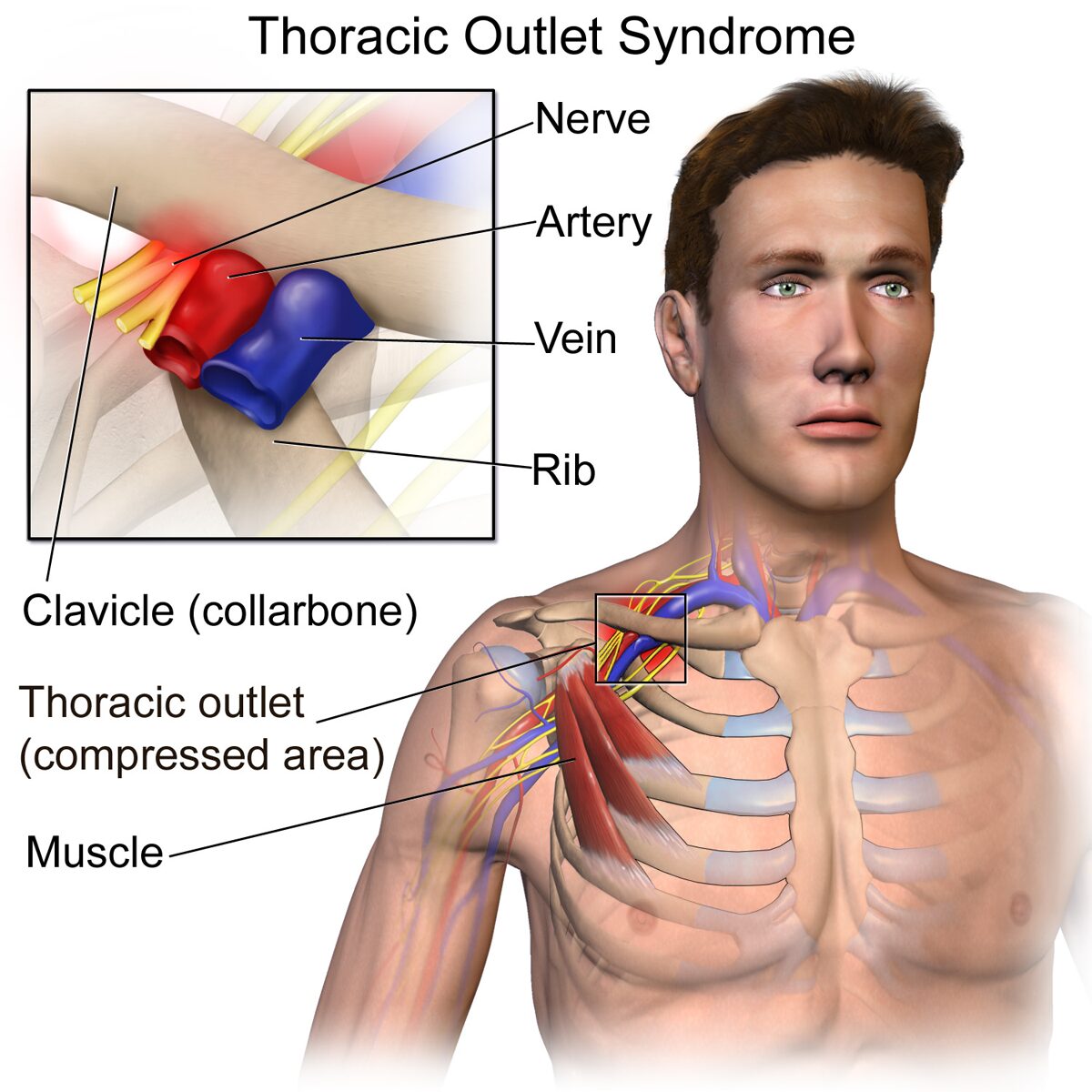Thoracic Outlet Syndrome: Symptoms, Causes, Treatment
What are the symptoms of thoracic outlet syndrome?
Thoracic outlet syndrome (TOS) is a condition caused by compression of the nerves or blood vessels that pass through the thoracic outlet, which is the space between your collarbone and first rib. The symptoms of TOS can vary depending on which structures are compressed, but common symptoms may include:
- Pain: Pain in the neck, shoulder, and arm is a common symptom of TOS. The pain may be sharp or dull and may worsen with certain movements or activities.
- Numbness or tingling: Compression of nerves in the thoracic outlet can cause numbness, tingling, or a pins-and-needles sensation in the arm or hand.
- Weakness: Weakness in the arm or hand may occur due to compression of nerves that control muscle function.
- Coldness or discoloration: Reduced blood flow to the arm or hand can cause the affected limb to feel cold or look pale or discolored.
- Swelling: Compression of blood vessels in the thoracic outlet can lead to swelling in the arm or hand.
- Fatigue: TOS can cause fatigue in the affected arm or hand, particularly with prolonged use.
- Muscle atrophy: In severe cases of TOS, compression of nerves can lead to muscle wasting (atrophy) in the affected arm or hand.
- Headaches: Some people with TOS may experience headaches, particularly if the condition is caused by compression of nerves that affect blood flow to the brain.
- Impaired circulation: Compression of blood vessels in the thoracic outlet can lead to impaired circulation, which can cause symptoms such as cold hands or fingers and changes in skin color.
It’s important to note that the symptoms of TOS can vary widely among individuals, and not everyone with TOS will experience all of these symptoms. If you are experiencing symptoms of TOS, it’s important to consult with a healthcare professional for an accurate diagnosis and appropriate treatment.
What are the causes of thoracic outlet syndrome?
Thoracic outlet syndrome (TOS) is caused by compression of the nerves or blood vessels that pass through the thoracic outlet, which is the space between your collarbone and first rib. This compression can be caused by a variety of factors, including:
- Poor posture: Slouching or holding the shoulders in a rounded position can compress the nerves and blood vessels in the thoracic outlet, leading to TOS.
- Repetitive movements: Activities or occupations that involve repetitive movements of the arms and shoulders, such as typing, carrying heavy loads, or playing musical instruments, can increase the risk of developing TOS.
- Trauma: A traumatic injury, such as a car accident or fall, can cause compression of the nerves or blood vessels in the thoracic outlet, leading to TOS.
- Anatomical abnormalities: Some people are born with an extra rib (cervical rib) or an abnormality in the shape of the first rib, which can increase the risk of TOS.
- Tumors: Tumors in the neck or chest, such as a tumor in the upper lung (Pancoast tumor), can compress the nerves or blood vessels in the thoracic outlet, leading to TOS.
- Muscle tightness or imbalance: Tightness or imbalance in the muscles of the neck, chest, or shoulder can contribute to compression of the nerves or blood vessels in the thoracic outlet.
- Pregnancy: Changes in posture and increased weight during pregnancy can increase the risk of developing TOS.
- Obesity: Excess weight can put pressure on the nerves and blood vessels in the thoracic outlet, increasing the risk of TOS.
- Poorly fitting backpacks or shoulder bags: Carrying a heavy backpack or shoulder bag that is not properly fitted can compress the nerves and blood vessels in the thoracic outlet, leading to TOS.
It’s important to note that the exact cause of TOS can vary among individuals, and in some cases, the cause may not be known. If you are experiencing symptoms of TOS, it’s important to consult with a healthcare professional for an accurate diagnosis and appropriate treatment.
What is the treatment for thoracic outlet syndrome?
The treatment for thoracic outlet syndrome (TOS) depends on the underlying cause and the specific symptoms experienced by the individual. Treatment may include:
- Physical therapy: Physical therapy is often recommended to improve posture, strengthen muscles, and improve range of motion. Specific exercises may be prescribed to stretch and strengthen the muscles of the neck, shoulders, and upper back.
- Postural training: Learning proper posture and body mechanics can help reduce pressure on the nerves and blood vessels in the thoracic outlet.
- Medications: Nonsteroidal anti-inflammatory drugs (NSAIDs) such as ibuprofen may be prescribed to reduce pain and inflammation associated with TOS.
- Nerve gliding exercises: These exercises can help improve the mobility of the nerves in the thoracic outlet and reduce compression.
- Massage therapy: Massage therapy can help relax tight muscles and improve circulation in the affected area.
- Surgical intervention: In severe cases of TOS that do not respond to conservative treatments, surgery may be recommended to relieve compression on the nerves or blood vessels in the thoracic outlet. Surgery may involve removing a portion of the first rib or releasing tight bands of tissue.
- Lifestyle modifications: Making changes to daily activities, such as avoiding repetitive movements or heavy lifting, can help reduce symptoms of TOS.
- Ergonomic modifications: Modifying workstations or using ergonomic tools, such as ergonomic keyboards or chairs, can help improve posture and reduce strain on the neck and shoulders.
It’s important for individuals with TOS to work closely with a healthcare professional to develop a treatment plan that is tailored to their specific needs and symptoms. With proper treatment, many people with TOS can experience relief from symptoms and improve their quality of life.




